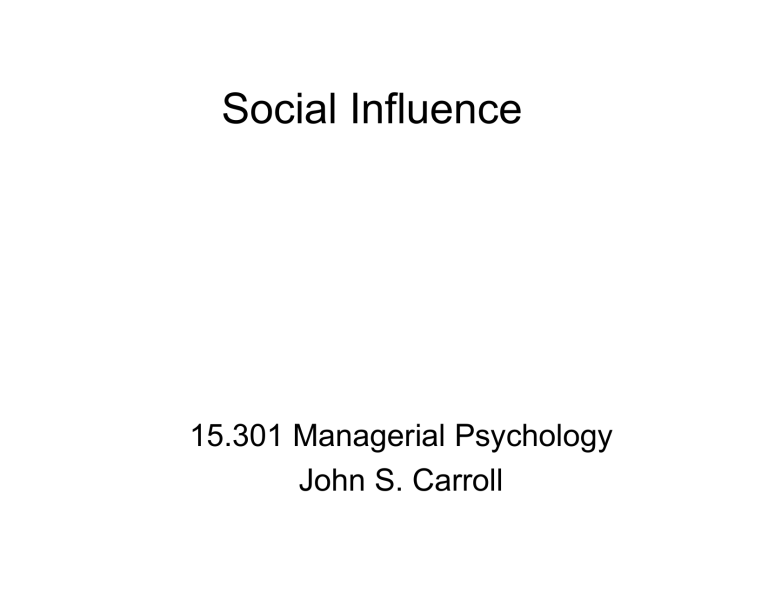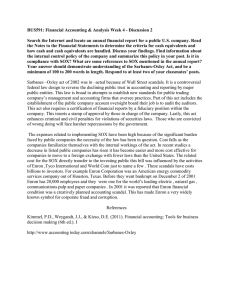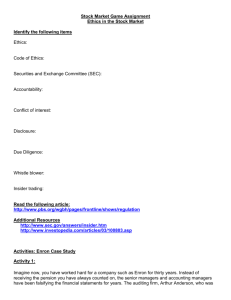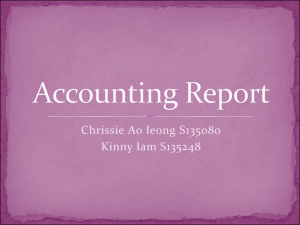Social Influence 15.301 Managerial Psychology John S. Carroll
advertisement

Social Influence 15.301 Managerial Psychology John S. Carroll Perceptual Task • Which matches the test line in length? test line A B C What Happened? • On some trials, the 3 other “subjects” gave the same wrong answer (e.g., A) • About 1/3 of real subjects then gave that answer • When asked, some said: – It looked like A to me – It looked like B, but the others must be right – It looked like B, but I don’t want trouble Kelman’s 3 Processes of Influence • Compliance - through control over rewards and punishments • Identification - through salience of selfdefining role relationships • Internalization - through personal value congruence of behavior to issues Which of these seem involved in the three explanations? Is It All Compliance? error rate • • • • • • • • • subject is alone 1 other person says “A” 2 others say “A” 3 or more say “A” anonymous judgments 6 say “A” and 1 says “B” group reward precommit on paper groups have different payoffs < 1% 3% 13% 33% 23% 6% 57% 14% 9% Minority Influence • • • • Reframe as innovation/creativity Minorities can shift the majority “Majorities coerce; minorities convert” How should minorities act? – be consistent, objective, competent – it takes two to influence the majority Persuasion • World War II research on soldier morale and civilian support Æ Yale Persuasive Communication Approach Source Æ Message Æ Channel Æ Audience • Source: attractive, familiar, similar, expert, trustworthy (likeable, credible) • Message: complexity, order, structure, fear • Channel: written, radio, face-to-face, … • Audience: bias, knowledge, expertise • E.g., 1-sided message better with + audience but 2sided message better with – audience • E.g., fear produces more change if specific possible actions are recommended, otherwise less change Communication Processing • • • • • Attention: volume, novelty, sex Comprehension: simplicity, repetition Acceptance: rewards Retention: slogans, tunes, novelty, repet. E.g., intelligent people comprehend better but accept less; let them draw own conclusions • E.g., fear produces less attention but more acceptance Press release on the Enron Corporation web site on February 6, 2001: Enron Named Most Innovative for Sixth Year HOUSTON -- Enron Corp. was named today the “Most Innovative Company in America” for the sixth consecutive year by Fortune magazine. “Our world-class employees and their commitment to innovative ideas continue to drive our success in today’s fast-paced business environment,” said Kenneth L. Lay, Enron chairman and CEO. “We are proud to receive this accolade for a sixth year. It reflects our corporate culture which is driven by smart employees who continually come up with new ways to grow our business.” Enron placed No.18 overall on Fortune’s list of the nation’s 535 “Most Admired Companies,” up from No. 36 last year. Enron also ranked among the top five in “Quality of Management,” “Quality of Products/Services” and “Employee Talent.” Corporations are judged primarily from feedback contained in confidential questionnaires submitted by approximately 10,000 executives, directors and securities analysts who were asked to rate the companies by industry on eight attributes. Enron is one of the world’s leading electricity, natural gas and communications companies. The company, with revenues of $101 billion in 2000, markets electricity and natural gas, delivers physical commodities and financial and risk management services to customers around the world, and has developed an intelligent network platform to facilitate online business. Fortune magazine has named Enron “America’s Most Innovative Company” for six consecutive years. Enron’s Internet address is www.enron.com. The stock is traded under the ticker symbol “ENE.” Influence Tactics Reason - facts, data, explanations Organizational rewards & punishments Assertive Pressure - direct, forceful demands Bargaining - exchange benefits, favors, promises Higher Authority - gain their support Legitimating Tactics - claim authority, rules, norms Coalition - mobilize others, bandwagon Personal Appeal - loyalty and friendship Ingratiation - create goodwill, good mood Success Å context, e.g., influence upward Inspiration - emotional appeal to values vs. downward Consultation - seek participation Common vision - group spirit, shared identity Commitment Tactics • Staw: “Too much invested to quit” • You are Financial VP of Adams & Smith company, allocate $20M extra R&D funds to Consumer vs. Industrial Products Divisions • 5 years ago, you (or someone else) had allocated $10M extra R&D to one division, and that division had done worse (better) • 2 X 2 design of personal responsibility X prior consequences: what do you predict and why? Self-Justification High personal responsibility $13M $11M Low personal responsibility $9M + prior consequences - prior consequences Foot-In-The Door • Freedman & Fraser had volunteer workers go door to door in residential CA neighborhood asking to allow a billboard DRIVE CAREFULLY to be put on their lawns (shown photo with very large and poorly lettered sign) • 17% said yes, except for one group • Two weeks before, a different volunteer asked some to display a 3 inch sign BE A SAFE DRIVER, and almost all had agreed • 76% of these agreed to display the large sign • Similarly, Cialdini et al found 24% of students agreed to a study of thinking processes where they come in at 7am; 56% agreed to the study, then when told it required a 7am start, NONE declined, and 95% showed up! When is an Order an Order? • We have discussed how, when people are told to do things, it reduces their perceived choice and intrinsic motivation • Indeed, orders and extrinsic rewards can undermine existing (intrinsic) motivation • In Eastern cultures, being told what to do by accepted authorities has a different meaning • Sethi & Lepper (1997) asked students to solve anagrams from a category they had chosen for themselves, or from a category chosen for them, measuring performance and later free play US and Asian Identification Time Spent in Free Play Anglo-American Asian-American Personal Choice Outgroup Choice Ingroup Choice Framing • A subtle but powerful form of influence is to set the language, categories, reference points, criteria, and agendas • Ronald Reagan was opposed to new taxes, but advocated a “user’s fee” • Lockheed Martin has a required ethics course entitled “Compliance Training” Your Influence Papers • What tactics did you use to generate influence? – Reciprocity – Escalating commitment – Conformity (social proof) – Ingratiation (liking) – Others? • How many for “real” vs. role-play? • Did you succeed? Not? Know why? Questions for Reflection • Why would you choose to use one influence tactic rather than another? • Can you tell when influence is being applied to you? What can you do? • How different is influencing upward, downward, sideways, in the workplace or in personal life? • What influence tactics are you comfortable using? skilled at using? • Which should you work to develop?




